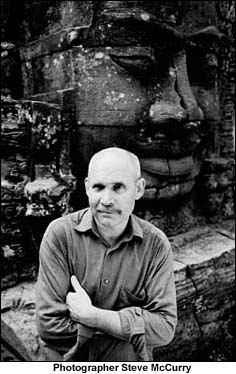THE
LUCKIEST PHOTOGRAPHER
Introduction by Dirck Halstead
When
I first became a Time Magazine contract photographer in the
early 1970s, the average time I spent on a story was six weeks.
These were big stories: Defense, The Navy, The New Beauties,
The New Cities. In those days, the only real competition for
the Magazine Photographer of the Year award came from the
photographers at National Geographic Magazine.
The
concept of a six-week assignment for any magazine just doesn't
work anymore. Photographers have become used to squeezing
difficult and heart-felt coverage into small blocks of time,
and money, that the bean counters will approve.
 One
of the rare exceptions to this way of thinking and working
is practiced by a guy who still marches to his own music,
at his own pace. His name is Steve McCurry.
One
of the rare exceptions to this way of thinking and working
is practiced by a guy who still marches to his own music,
at his own pace. His name is Steve McCurry.
For
more than 20 years he has dominated a whole area of magazine
photojournalism. In the year he won Magazine Photographer
of The Year, given by the National Press Photographer's Association,
he also garnered an unprecedented four first prize awards
in the World Press Photo Contest. In his career, he has survived
a plane crash at sea, a beating and near drowning in India
by zealous crowds at a religious festival, and was nearly
killed by a rival Mujahadeen faction. He was reported killed
twice.
McCurry has assembled a prodigious body of work, with four
books and countless international exhibitions.
At
a time when most photojournalists are struggling just to get
the next assignment, McCurry feels that the stories he is
offered today are better than ever before. Because he hates
the cold, he arranges to spend most of the U.S. winter in
some far-flung, warmer place. His passion has been Southeast
Asia and the subcontinent. These are the places he goes to
find the kind of subdued, rich light he so loves.
"My
favorite light is found on an overcast day. On a sunny day
people's eyes squint. I love the monsoon, a dark and rainy
afternoon," he says.
In 1984, in an Afghan refugee village, he saw a young girl
sitting in a classroom. "She had such intense eyes, there
was something really haunting about her. The color scheme
of the shawl and the tent were compelling." The photograph
would go on to become an icon. First published on the cover
of National Geographic, then on dozens of other magazines
around the world.
McCurry
grew up in suburban Philadelphia, and worked on local newspapers
there. In 1980, he decided it was time for him to take a crack
at international photojournalism. He disguised himself in
native garb and crossed the Pakistan border into rebel-controlled
Afghanistan, just before the Russian invasion. When he emerge
with his film sewn into his clothes, his coverage, first published
by Time, won the Robert Capa Award for Best Photographic Coverage
from Abroad, an award dedicated to photographers displaying
exceptional courage and enterprise.
His
work in Southeast Asia and the subcontinent is in a class
by itself. McCurry says, "When you work here, it's like going
back in time. It's like going back to the bible from the way
people look and dress...India fascinates me, because it is
like the dark side of the moon...so different from where I
grew up." If Steve McCurry has led a lucky life, we are all
the luckier for it.